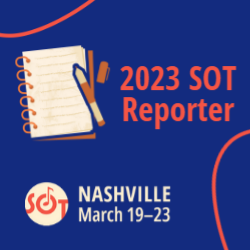
The “Biomarkers” Poster Session at this year’s SOT Annual Meeting and ToxExpo was marked by good representation from both industry and academia. The session included 19 posters ranging from validating a new methodology (T2-MRI mapping and lymphocyte genome sensitivity test, to name a few) to quantifying biomarkers and identifying newer biomarkers for organ toxicity (miRNA, cell free DNA, senescence markers, etc.).
One of the posters that drew a lot of attention was for abstract #3717, “Hepatocyte Senescence Is Initiated through a Klf6-p21 Mechanism That Mediates the Production of Cxcl14, a Novel Prognostic Biomarker of Acute Liver Failure,” which was awarded the Carl C. Smith Graduate Student Award by the SOT Mechanisms Specialty Section. The presenting author for this poster, David S. Umbaugh, is a graduate student at University of Kansas Medical Center and is studying the signaling network between cells in liver injury. In this work, Umbaugh identified a new mechanism mediated by Klf6-p21 to induce hepatocyte senescence on acetaminophen (APAP)-induced acute liver injury. This was an extensive work, employing tools like CRISPR (for gene activation) and senolytics treatment (for suppression) to establish the role of Klf6-p21-Cxcl14 axis in APAP-induced senescence in hepatocytes.
Age-related cellular senescence was also targeted by Dr. Irfan Rahman’s group at the University of Rochester Medical Center. In its work, Dr. Rahman’s group optimized a flow-based C12FdG assay to determine the individual cell type–based cellular senescence in young and old C57BL/6J mice. The flow data was further validated through single-cell RNA sequencing technique to strengthen the findings and identify specific biomarkers for age-associated senescence in mice.
A group from Altasciences optimized a way to detect pSTAT5 using detector fluorophore conjugated flow cytometry. pSTAT5 is a marker for T-cell proliferation. While methods like immunoblotting could be used to study the expression of phosphorylated STAT5 in T-cells, it is quite labor intensive. Considering this, the current method promises more precision and reproducibility.
A few posters exhibited use of miRNAs as markers to indicate organ toxicities. While miRNAs are being validated as biomarkers for various disease conditions by both academia and industry, it was interesting to see the enthusiasm among presenters and the audience in optimizing better techniques like Nanostring and RNA sequencing to quantify these in various biological fluids.
The turn out of people for this session and the 2023 SOT Annual Meeting and ToxExpo in general was much better than last year. The “Biomarkers” Poster Session, in particular, had posters from international institutions and agencies. It was quite uplifting to meet and interact with presenters from the United Kingdom, Germany, Japan, and Korea, who traveled to present their work and attend the SOT meeting this year.
In terms of content, the session had a good balance of posters covering all the major areas of toxicology, including hepatic, pulmonary, and nephro- and neurotoxicity. Overall, this morning Poster Session was successful in engaging the audience and displaying the recent advances made in biomarker development for toxicological studies.
This blog reports on the Poster Session titled “Biomarkers” that was held during the 2023 SOT Annual Meeting and ToxExpo.
This blog was prepared by an SOT Reporter and represents the views of the author. SOT Reporters are SOT members who volunteer to write about sessions and events in which they participate during the SOT Annual Meeting and ToxExpo. SOT does not propose or endorse any position by posting this article. If you are interested in participating in the SOT Reporter program in the future, please email SOT Headquarters.
#Communique:ScienceNews#2023AnnualMeeting#SOTReporter#Communique:AnnualMeeting